IUCN/SSC Otter Specialist Group Bulletin

©IUCN/SCC Otter Specialist Group
Volume 38 Issue 2 (March 2021)
Citation: Wai, L., Burger, R. and Goossens, B. (2021). The First Documented Record of Hairy–Nosed Otter (Lutra sumatrana) in the Lower Kinabatangan Wildlife Sanctuary, Sabah, Malaysia. IUCN Otter Spec. Group Bull. 38 (2): 62 - 69
Incidental Sightings of the Vulnerable Asian Small-Clawed Otter (Aonyx cinereus) in Assam, India: Current and Future Threats
Leona Wai1,2, Richard Burger1,2, and Benoit Goossens1,2
1Danau Girang Field Centre, c/o Sabah Wildlife Department, Wisma MUIS, Block B, 5th Floor, 88100 Kota Kinabalu, Sabah, Malaysia. E-mail leonawai22@gmail.com
2Organisms and Environment Division, Cardiff School of Biosciences, Cardiff University, Sir Martin Evans Building, Museum Avenue, Cardiff CF10 3AX, UK.
(Received 20th May 2020, accepted 18th August 2020)
Abstract: On 7th March 2020, L. sumatrana was sighted and video recorded in an oil palm plantation within the Lower Kinabatangan Wildlife Sanctuary (LKWS). This was the first documented sighting of L. sumatrana within the LKWS, which suggests that this endangered otter species still persists within the degraded landscape. In addition, on the 8th September 2020, a roadkill of a hairy-nosed otter was found at a village about 30 km from the location of the first recorded sighting of hairy-nosed otter. Based on this finding, the LKWS acts as an essential wildlife corridor for endangered species such as L. sumatrana, which connects forest reserves such as Deramakot Forest Reserve and Tabin Wildlife Reserve. Very little is known about this rare species in Sabah due to a lack of scientific research. Therefore, targeted research on L. sumatrana is urgently needed to identify important otter habitat and establish a species management plan in Sabah.
Keywords: Lutra sumatrana, degraded forest, Kinabatangan, Borneo
INTRODUCTION
One of the least known otter species, Lutra sumatrana is distributed across Southeast Asia; Thailand, Cambodia, Vietnam, Peninsular Malaysia, Borneo and Java (Kruuk, 2006; Payne and Francis, 2007; Phillips and Phillips, 2016). In the past, direct sightings of L. sumatrana were very rare and its occurrence was only determined by roadkill carcasses from Indonesia (Lubis, 2005) and Malaysia (Tan, 2015) and specimen records (Hiroshi et al., 2009). Recently, the species has been rediscovered via direct sightings and photographic evidence in many regions such as Cambodia in 1998 (Long, 2000), Sumatra in 2013 (Latifiana and Pickles, 2013) and Vietnam in 2000 (Dang et al., 2011). In Sabah, Malaysian Borneo, L. sumatrana was not seen for about 100 years and rediscovered in Deramakot Forest Reserve via a camera trap image (Wilting et al., 2010). Since then, there have been a few sightings around Sabah; Tabin Wildlife Reserve (Ishigami et al., 2017), Deramakot Forest Reserve (Guharajan pers comm., 2018; Gordon, pers comm., 2019) and Danum Valley Conservation Area (Pain pers comm., 2019).
Little is known about the habitat preferences of this very elusive otter species as it is very difficult to observe in the wild, thus only a few studies have been conducted on free-ranging L. sumatrana. This species is believed to occur in swamp forest, mangrove forest, lowland flooded forest, mountain streams and occasionally, oil palm plantation streams (Kruuk, 2006; Latifiana and Pickles, 2013; Payne and Francis, 2007; Phillips and Phillips, 2016; Sivasothi and Nor, 1994; Wright et al., 2008). In the IUCN Red List, L. sumatrana is listed as Endangered, while in the Sabah Wildlife Conservation Enactment 1997, this species is listed in Schedule 2 (Protected Species). The knowledge on the population status of L. sumatrana in Sabah remains patchy due to lack of scientific surveys and research. Therefore, scientific research on this endangered species is urgently needed to better understand the ecology of the species for establishing conservation management planning.
SIGHTING DETAIL
Location (Map)
The sighting occurred along a man-made ridge at the boundary of an oil palm plantation in Lot 6 of the Lower Kinabatangan Wildlife Sanctuary (LKWS), located on the east coast of Sabah, Malaysia (Fig. 1). GPS coordinates of the sighting is N5.40505° E118.08327°. The oil palm plantation ridge is a raised area bordering the plantation, to prevent flooding from the Kinabatangan river, and planted with bamboo. The area is located adjacent to a swamp, a tributary, and the main river.
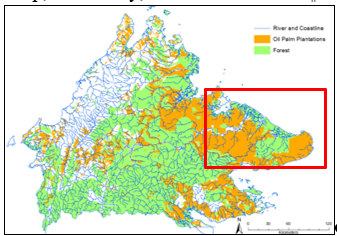

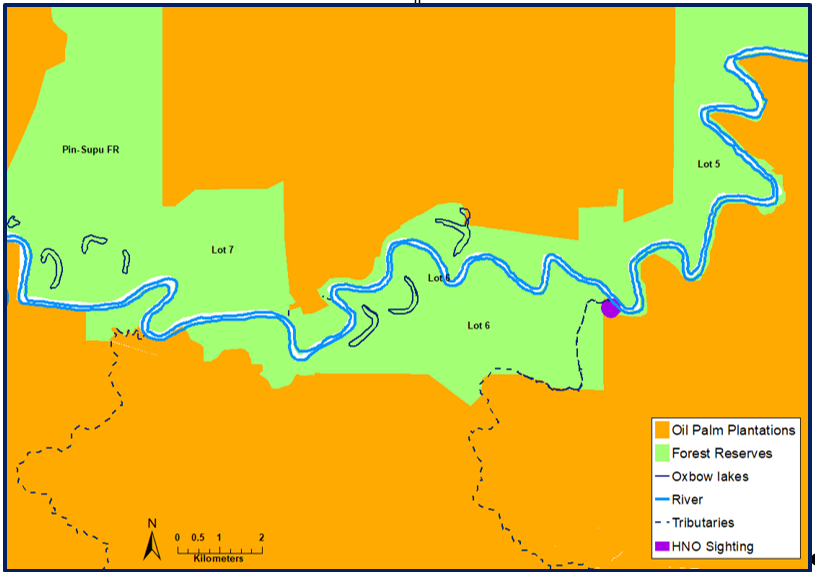
Since the 1950s, the LKWS has undergone drastic human changes in the form of logging and agriculture, predominantly being converted into monoculture landscapes of oil palm plantation (Ancrenaz et al., 2004). Abram et al. (2014) stated that 250,617 ha (48%) of Kinabatangan forest were converted into oil palm plantation. In 2002, the Sabah Wildlife Department gazetted a 27,000 ha area of the lower Kinabatangan floodplain as a Wildlife Sanctuary and divided it into 10 lots under provision of the Sabah Wildlife Conservation Enactment 1997. Despite the intense habitat fragmentation happening around the wildlife sanctuary, several Bornean species such as Bornean elephant (Elephas maximus borneensis), Sunda clouded leopard (Neofelis diardi), Malayan sunbear (Helarctos malayanus) and binturong (Arctictis binturong) still persist in the floodplain (Abram et al., 2014; Ancrenaz et al., 2004; Evans et al., 2016). The LKWS provides an important forest corridor to connect forest reserves such as Deramakot Forest Reserve and Tabin Wildlife Reserve (Evans et al., 2016). The mean temperature of the area ranges from 21–34 °C (Ancrenaz et al., 2004) and average annual rainfall is 3,000 mm with occasional flooding and drought (Estes et al., 2012).
Time and conditions
The sighting occurred along a man-made ridge at the border of a large oil palm plantation. The ridge is planted with bamboo, and also fenced with electrified wire, which is only turned on when Bornean elephants (Elephas maximus borneensis) are in the vicinity. It is bordered on the North by a riparian buffer zone of forest along the Kinabatangan river, with a minimum width of around 50m. On 7th March 2020, at 9.30 am, Richard Burger was walking with other researchers along the path along the top of the ridge, and observed a lone otter running towards them along the ridge path, heading East. The weather was clear and sunny. They remained motionless and quiet, while observing and filming the otter running towards them. Once the otter got to within ~15m, it slowed down and became more cautious, but still continued to move in their direction, appearing to be highly curious, until it was within 1 – 2m. It did not appear to be able to observe them clearly while they remained motionless, but it was frightened when Richard moved slightly due to filming the animal. It let out a brief snorting sound, and ran away off the ridge.
Compared to other otter species on Borneo, L. sumatrana (Fig. 2) has a few distinctive features such as its hairy rhinarium, white fur on the lips and upper throat and dark coat (Kruuk, 2006; Payne and Francis, 2007; Wright et al., 2008). This species weight ranges from 7 – 8 kg, while their head – body length ranges from 50 – 60 cm (Payne and Francis, 2007; Wright et al., 2008). This species is usually found solitary or in pairs, rarely in groups (Kruuk, 2006; Payne and Frances, 2007). The main diet of this species is fish, occasionally snakes, frogs, crabs, insects and small mammals (Kanchanasaka, 2001; Kruuk, 2006).
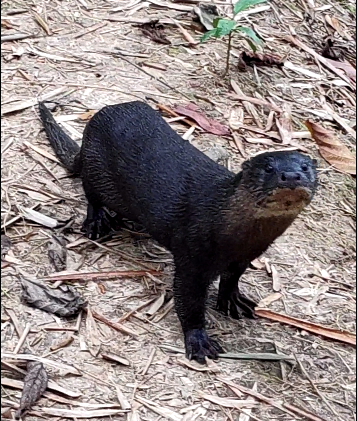
DISCUSSION
The occurrence of this rare otter species in degraded habitat could suggest that it may have higher tolerance towards human disturbance and may exist in broader range of habitats than originally presumed. This otter might have been sighted previously by the locals; however, they are generally unable to differentiate the four Bornean otter species (Wai, unpublished data). Therefore, education awareness on otters is needed to educate the local community in Sabah about the ecology and importance of otters. Moreover, this finding suggests that citizen science is urgently needed to gather local information on this endangered otter species by interviewing the local residents especially within the riverine community.
This finding also highlights the importance of LKWS as a wildlife corridor as it connects central forests such as Deramakot Forest Reserve to mangrove forests in the east coast of Sabah such as Tabin Wildlife Reserve, where L. sumatrana was previously recorded. Even though this rare species was sighted in the oil palm plantation, it is unlikely that L. sumatrana favors oil palm habitat. The area of sighting was in close proximity to swampy areas and the main river; the otter may have come from the swamp area and used the oil palm plantation ridge as a passage to the main river. While there have been a few records of L. sumatrana in Sabah, this information is not sufficient to assess their population status in the state. Therefore, it is imperative to conduct statewide surveys in Sabah to determine the population status and distribution of L. sumatrana and use this information to develop a species management plan and identify critical habitat for this endangered species.
ADDITIONAL INFORMATION
On the 8th September 2020, during the reviewing process of this paper, a roadkill of a hairy-nosed otter (Fig. 3) was found at Batu Puteh village, about 30 km from the location of the first recorded sighting of hairy-nosed otter in LKWS in 7th March 2020. The GPS location of the carcass was N5.408049° E117.948428°. According to the witness, Norsalleh Taing, there were 4 individuals crossing the road, and then a lorry hit one of the hairy-nosed otters. He then hurried to rescue the otter but the injuries were too critical and the otter died shortly thereafter. The carcass was brought to a veterinary clinic for post-mortem and measurements (Fig. 3 and Table 1) and the post-mortem was performed by Danau Girang Field Centre’s veterinary, Dr. Macarena Gonzalez and Dr. Sergio Guerrero-Sanchez. Blood, serum, muscle, tissue and hair samples as well as important organs such as heart, lung, liver, stomach, intestines and kidney were extracted for forensic, genetic, diet and toxicology purposes. Samples were stored in a freezer (-80 °C) in Wildlife Health, Genetic and Forensic Laboratory, Potuki prior to analysis. The skull and skin samples were extracted at Museum Sabah, to be kept as a museum specimen collection. This roadkill is a very important finding in otter conservation in Sabah as we now have a confirmed DNA sample of a local hairy-nosed otter.
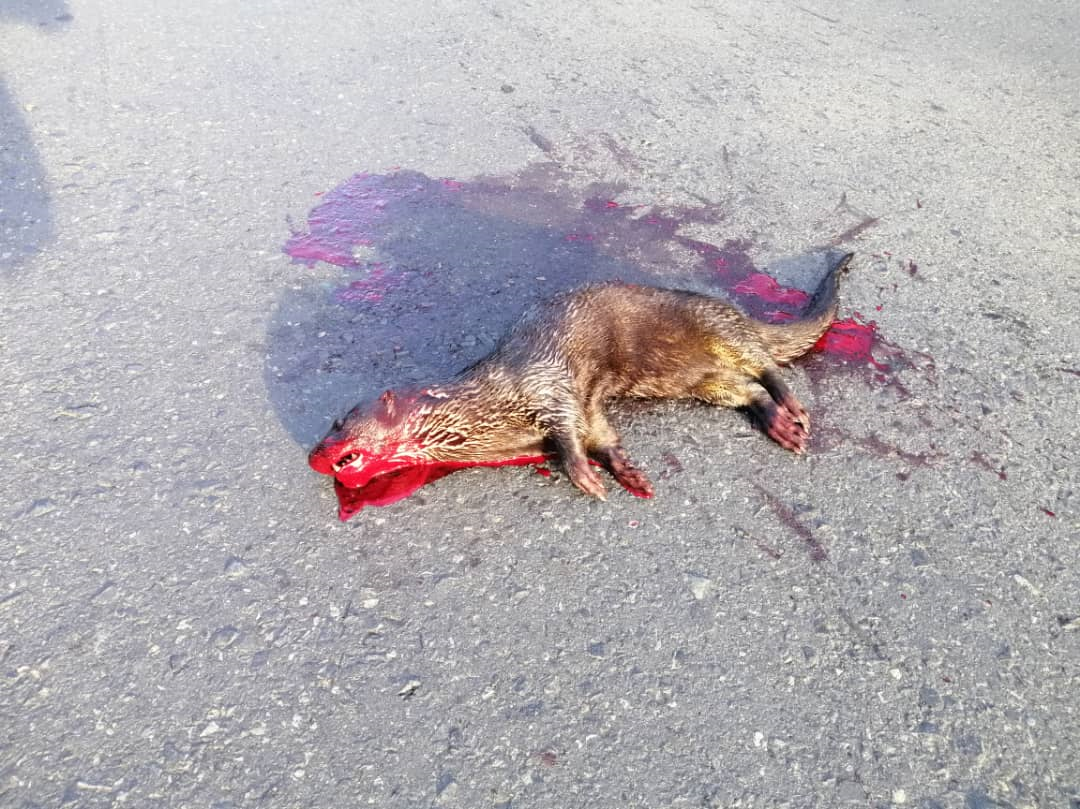
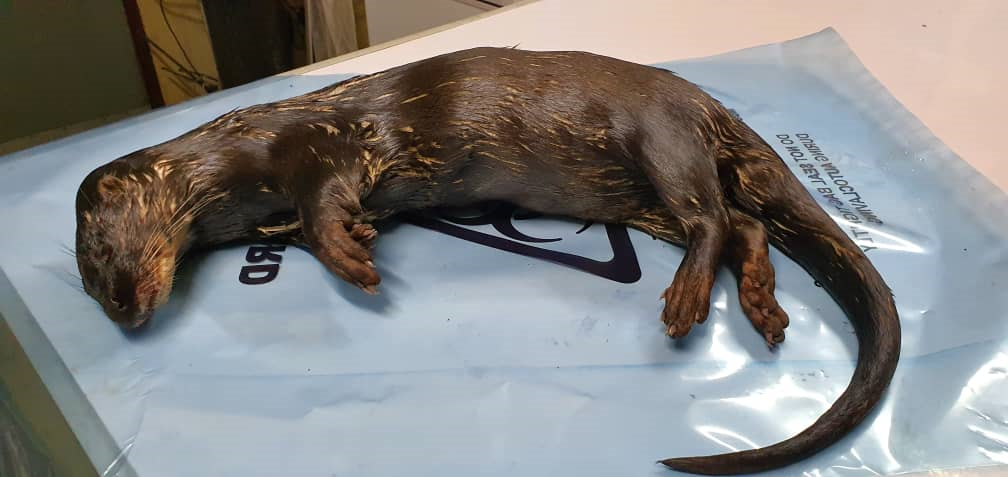


Acknowledgements: Sincere thanks to the IUCN Otter Specialist Group members for helping in the identification of the otter species. Deepest thanks to Nazrul bin Moh Natsyir, Nurul Aizatul, Nur Syafawati and Valerie Poinson for spotting this rare otter species as well as to Samsir, Elisa, Maz, Amanda, Ray, Ashraft, Dr. Liesbeth, Nurhartini and Alwanie for assisting in the post-mortem process. Special thanks to the Museum Sabah for extracting and storing the skull and skin sample. Many thanks are extended to the Sabah Wildlife Department for supporting our work in the LKWS.
REFERENCES
Abram, N. K., Xofis, P., Tzanopoulos, J., Macmillan, D. C., Ancrenaz, M., Chung, R., Peter, L., Ong, R., Lackman, I., Goossens, B., Ambu, L., Knight A. T. (2014). Synergies for improving oil palm production and forest conservation in floodplain landscapes. PLoS ONE 9(6): 1-12.
Ancrenaz, M., Goossens, B., Gimenez, O., Sawang, A., Lackman-Ancrenaz, I. (2004). Determination of ape distribution and population size using ground and aerial surveys: a case study with orang-utans in lower Kinabatangan, Sabah, Malaysia. Animal Conservation 7: 375-385.
Dang, N. X., Anh, P. T., Tuyen, L. H. (2001). New information about the hairy-nosed otter (Lutra sumatrana) in Vietnam. IUCN Otter Specialist Group Bulletin 18(2): 1–8.
Estes, J. G., Othman N., Ismail S., Ancrenaz M., Goossens B., Ambu L. N., Estes A. B., Palmiotto P. A. (2012). Quantity and configuration of available elephant habitat and related conservation concerns in the Lower Kinabatangan Floodplain of Sabah, Malaysia. PLoS ONE 7: e44601.
Evans, M. N., Vickers, S. H., Abu-Bakar, M. S., Goossens, B. (2016). Small carnivores of the Lower Kinabatangan Wildlife Sanctuary, Sabah, Borneo, including a new locality for the otter civet Cynogale bennetti. Small Carnivore Conservation 54: 26-38.
Hiroshi, S., Burhanuddin, M.N., Budsabong, K. (2009). Past and present distribution of the Hairy-nosed Otter Lutra sumatrana Gray 1865. Mammal Study 34: 223-229.
Ishigami, J., Ambu, L. N., Tuuga, A., Tsubouchi, T. (2017). The second recent record of hairy-nosed otter (Lutra sumatrana) in Sabah, Malaysia. IUCN Otter Specialist Group Bulletin 34 (1): 67 – 72
Kanchanasaka, B. (2001). Tracks and other signs of the hairy-nosed otter (Lutra sumatrana). IUCN Otter Specialist Group Bulletin 18(2), 2–7.
Kruuk, H. (2006). Otters: ecology, behaviour and conservation. Oxford: Oxford University Press.
Latifiana, K., Pickles, R. (2013). New observation of the hairy-nosed otter (Lutra sumatrana) in Sumatra. IUCN Otter Specialist Group Bulletin 30(2). 119-123.
Long, B. (2000). The hairy-nosed otter (Lutra sumatrana) in Cambodia. IUCN Otter Specialist Group Bulletin 17(2): 91.
Lubis, R. (2005). First recent record of hairy-nosed otter in Sumatra, Indonesia. IUCN Otter Specialist Group Bulletin. 22(1): 14-20.
Payne, J., Francis, C. M. (2007). A Field Guide to the Mammals of Borneo. Kota Kinabalu: The Sabah Society.
Phillips, Q., Phillips, K. (2016). Mammals of Borneo and Their Ecology: Sabah, Sarawak, Brunei and Kalimantan. Kota Kinabalu: Natural History Publications (Borneo).
Sabah Wildlife Department. (1997). Sabah Wildlife Conservation Enactment 1997.
Sivasothi, N., Nor, B. H. M. (1994). A review of otters (Carnivora: Mustelidae: Lutrinae) in Malaysia and Singapore. Ecology and Conservation of Southeast Asian Marine and Freshwater Environments including Wetlands 285: 151-170.
Tan, H. H. (2015). A roadkill record of a hairy-nosed otter (Lutra sumatrana) from Selangor, Peninsular Malaysia. IUCN Otter Specialist Group Bulletin 32(1): 8–11.
Wilting, A., Samejima, H., Mohamed, A. (2010). Diversity of Bornean viverrids and other small carnivores in Deramakot Forest Reserve, Sabah, Malaysia. Small Carnivore Conservation 42: 10-13.
Wright, L., Olsson, A., Kanchanasaka, B. (2008). A working review of the hairy-nosed otter (Lutra sumatrana). IUCN Otter Specialist Group Bulletin 25(1): 38–59.
Résumé: Premiere Observation de la Loutre de Sumatra (Lutra sumatrana) dans la Réserve Faunistique du Bas Kinabatangan, au Sabah, en Malaysie
Le 7 mars 2020, L. sumatrana a été aperçue et une vidéo a été enregistrée dans une plantation de palmiers à huile de la Réserve Faunistique du Bas Kinabatangan (RFBK). Il s'agissait de la première observation documentée de L. sumatrana dans la RFBK, ce qui suggère que cette espèce de loutre en voie de disparition est toujours présente dans ce paysage dégradé. De plus, le 8 septembre 2020, une loutre de Sumatra, tuée suite à un accident de la route, a été trouvée dans un village à environ 30 km du lieu de la première observation enregistrée. Sur base de cette découverte, le LKWS se comporte comme un corridor faunistique essentiel pour les espèces menacées telles que L. sumatrana, et qui relie les réserves forestières telles que celle de Deramakot et la réserve faunistique de Tabin. On en sait très peu sur cette espèce rare au Sabah en raison d'un manque de recherche scientifique. Par conséquent, une recherche ciblée sur L. sumatrana est nécessaire de toute urgence pour identifier un habitat à loutre important et établir un plan de gestion de l’espèce au Sabah.
Revenez au dessus
Resumen: Primer Registro Documentado de Nutria Sumatrana (Lutra sumatrana) en el Santuario de Vida Silvestre del Kinabatangan Inferior, Sabah, Malasia
El 7 de Marzo de 2020, fue avistada y registrada en video una L. sumatrana, en una plantación de palmera aceitera del Santuario de Vida Silvestre del Kinabatangan Inferior (LKWS). Este fue el primer avistamiento documentado de L. sumatrana dentro del LKWS, lo que sugiere que esta especie amenazada de nutria aún persiste en el paisaje degradado. Adicionalmente, el 8 de Septiembre de 2020 se encontró un ejemplar de nutria de Sumatra atropellado, en un poblado a unos 30 km del sitio del primer avistamiento registrado de esta especie. Basados en éste hallazgo, el LKWS actúa como un corredor de fauna esencial para especies amenazadas como L. sumatrana, que conecta reservas forestales como la Reserva Forestal Deramakot y la Reserva de Vida Silvestre Tabin. Se sabe muy poco acerca de esta especie rara en Sabah, debido a la falta de investigación científica. Por lo tanto, se necesita urgentemente investigación focalizada en L. sumatrana, para identificar hábitat importante para las nutrias y establecer un plan de manejo de la especie en Sabah.
Vuelva a la tapa